
New Orleans may be most famous for its yearly Mardi Gras celebrations, but it's also one of the oldest cities in the United States with an enriched and intriguing history. Founded in 1718 by a French colony and later absorbed by the Spanish Empire, it is the largest city in Louisiana, straddling the Mississippi River just before it empties into the Gulf of Mexico.
New Orleans has earned a reputation of being the most haunted city in America, with 200 years of legendary ghost tales, haunted locations and paranormal activity. Perhaps by understanding a little of this city’s storied past, it is easier to comprehend why there are so many haunted locations in one place.
Since its beginning, New Orleans has enjoyed a multicultural, multiethnic, and multi-denominational populace. It has, however, endured numerous catastrophes and tragedies through the years, including two major fires in the late 1700s, several devastating hurricanes and floods, violence, wars and some of the nation’s worst epidemics and diseases.
Because of its long history of devastation and disaster, there are many alleged ghosts and ghouls that reside in this beautiful and eclectic southern city. Many of them had their lives tragically cut short, taken before their time and have not yet ‘crossed over’ to the other side. Legend has it that these spirits often stroll along the streets, haunt the hotels, lurk in the swamps and live among us in a state of restless confusion, effectively trapped between two worlds.
Originally a massive swamp, some of the first inhabitants of New Orleans were French prisoners and slaves who had been sent from France to establish a settlement on the Mississippi River for trading. Developing and building the city would not be easy as the settlers were met by hostile Native Americans who had supposedly used the area as a sacred Indian burial ground. The original settlers experienced living conditions that were some of the worst imaginable, with swamp infestations that included mosquitoes, alligators and snakes.
New Orleans grew in notoriety as early as the American Revolution, when the city was used as a port for smuggling military equipment, supplies and American rebels up the Mississippi River.
During the War of 1812, the citizens of New Orleans, under the leadership of General Andrew Jackson, fought off British troops in the Battle of New Orleans. During the War Between the States, between 1861 and 1865, New Orleans was captured and occupied by Union Troops.
One of the biggest catastrophes to hit New Orleans over the years was undoubtedly the yellow fever epidemic. During the 1800s, New Orleans was ravaged by the disease, killing over 40,000 people in a 100 year period. Many southern port cities were particularly vulnerable to the disease, but New Orleans with its humid climate and mosquito infested swamps would see a death toll as high as 7800 people in a peak epidemic year. Entire families were wiped out, and immune gravediggers could not keep up with the rate of deaths. Proper burials were not always possible, and mass, shallow trenches were sometimes dug to bury many corpses at a time. Torrential rain and shallow graves would cause horrifying scenes where decaying bodies surfaced and washed onto the streets. Sadly, it would be nearly 100 years before it would become known that yellow fever is a mosquito-borne disease and that New Orleans was the perfect breeding ground for it.
Being surrounded by water, New Orleans is home to one of the most elaborately engineered water systems in the world. Since its beginning, it has had its hydrology altered, intended to both protect the city from flood damage and to reroute water from swampy marsh areas to make land and water more usable. Complex waterways were constructed, including canals that would connect the Mississippi River to Lake Ponchatrane. These canals, primarily constructed by Irish immigrants, came at a high cost as thousands of men died from diseases contracted in the swamps while building the canals. Many of them were buried right where they dropped.
Most recently, New Orleans experienced additional devastation by Hurricane Katrina, sweeping through the area in 2005 and flooding nearly 80 percent of the city.
It has been said that the dead outnumber the living in New Orleans 10:1. Ghost stories involving haunted cemeteries, voodoo curses, Soldiers, pirates and murder are just a few of the legendary tales that can be heard on New Orleans’ numerous haunted tours.
One thing to keep in perspective about New Orleans is that the landscape has continually changed as the city was developed and has progressed over the years. A street or highway may now be paved over what used to be a canal that was no longer in use, a subdivision or a house might stand on what used to be swampland and a building may very well be placed over what used to be a grave or cemetery 200 years ago. What may look seemingly innocent today may very well be haunted by activity or an apparition from years past.
Join us as we highlight just a few of the ghostly locations in New Orleans. This, of course, is not a complete list but will give you a preview of the chilling paranormal activity that can be found in New Orleans - America’s Most Haunted City.
St. Louis Cathedral

Location:
615 Pere Antoine Alley
Jackson Square
New Orleans, Louisiana
The St. Louis Cathedral has undergone several restorations and rebuilding efforts since 1718, when the first crude church was built on the site. The second church constructed on the site was built of timber and brick. In 1788, the massive fire that swept through the French Quarter devastated the St. Louis Cathedral, as well as numerous other homes, businesses, and churches.
The fire was believed to have been started by a candle catching fire to lace draperies of an altar in a private home. The event has been dubbed the "Good Friday fire." Several months later, a hurricane swept through the city and destroyed yet more homes and businesses, causing significant injuries and death. In 1794, the Spanish built a beautiful cathedral on the site, complete with a bell tower, with the bell and the clock coming from Paris.
However, by 1849, the church grew too small for the local populace, and in 1850, renovation and expansion was planned. Unfortunately, during the restoration, the large, central tower collapsed and the entire cathedral had to be rebuilt. Since 1850, the St. Louis Cathedral still stands strong, though it is reputed to be one of the most haunted locations in New Orleans.
Claims of ghosts and paranormal activity at the cathedral range from the sound of someone singing the Kyrie in the area between the cathedral and the cemetery, to claims of apparitions noted in numerous locations throughout the cathedral and the adjoining cemetery property. According to legend, the haunting of the cathedral began with the death of six rebels executed by a firing squad and bayonet. Authorities refused their burial and the corpses were left outdoors to decompose in the New Orleans heat and rain.
The story goes that Pere Dagobert (a Father of the Cathedral) went to the homes of the men that had been killed and told their loved ones to go to the cathedral. There, the families found the bodies of their loved ones, although no one could determine how they had gotten there. The funeral mass was performed, and all six men were eventually entombed in St. Louis Cemetery No. 1 (more on that later). The incident was dubbed a miracle, as no one could understand how Pere Dagobert could have managed to steal the bodies from under the nose of Spanish Soldiers guarding them.
It is believed that the sound of singing in the area between the cathedral and the cemetery is that of Pere Dagobert. Interestingly, the first recorded burial ground in New Orleans, St. Peter’s Cemetery, is located next to the cathedral in the French Quarter, used between 1721 and 1800. After the cemetery property was filled, it was built over, and as construction in the city increased, remnants of the old cemetery as well as its bones have turned up.
Another ghost believed to haunt the St. Louis Cathedral is that of Pere Antoine. The friar at the time had the reputation of a living saint, and many swear that they have seen him careening along the streets that border the cathedral, rushing to provide aid, succor and support to New Orleans inhabitants. This ghost is apparently seen during daylight hours as well as nighttime.
One woman claims she was rushing through a deserted alley one rainy afternoon when she tripped. She fell, but instead of hitting the ground, she claims she fell into the arms of an old man with a white beard, wearing a black robe. After she'd regained her footing and turned to thank him, he was gone. The woman also claims to have felt an overwhelming sense of peace when in his arms.
A portrait of Pere Antoine, completed in 1822, hangs in the vestibule of the church. Like the woman who fell in the alley, many have claimed to see an old man similarly described with a long white beard, wearing a black robe. There have been reports of individuals who have seen him hovering near the altar during services, while others claim to have seen him sitting up in the choir loft during church services with a serene smile, enjoying the service.
The bell tower of the cathedral itself is purported to be haunted. The story goes that Pere Antoine oversaw the building of the tower, beginning in 1819. In 1820, yellow fever swept through New Orleans, decimating a large number of inhabitants, including Benjamin Latrobe, the builder commissioned to complete the tower.
Immediately following Latrobe’s death, workers, visitors and passersby believed they saw his ghost in and around the bell tower. Workers, frightened by the ghostly images, refused to work alone, asking instead to be placed in pairs. The bell in the tower rang by itself, even when there was no wind, and workers claimed that their supplies, paint, buckets and ladders moved by themselves.
Other ghostly haunts and apparitions are seen in the cathedral to this day, including up in the organ loft. Since 1829, numerous witnesses have reported seeing a woman clothed in a dark, flowing dress, reminiscent of clothing from the mid-1800s, staring down at them from the organ loft. She appears to many as being frustrated, angry, or desperate to communicate. Many witnesses claim that she is always on the verge of crying. Sometimes, weeping can be heard up in the organ loft.
Other individuals who were important in the construction of the cathedral or in St. Louis’ history itself are claimed to haunt the property as well. The history of the cathedral is extremely detailed, and due to its age, is filled with fascinating stories, individuals, and events. Today, the St. Louis Cathedral, one of the oldest churches in Louisiana, still holds regular masses.
Le Pavillion Hotel
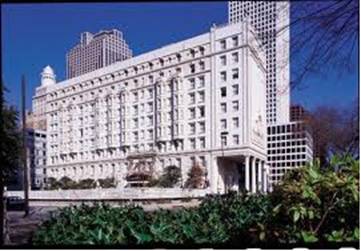
Location:
833 Poydras Street
New Orleans, Louisiana
Visitors to New Orleans have quite a choice when it comes to reputedly haunted hotels. The historic French District has a reputation of being quite haunted, whether you are in a bed and breakfast, a hotel, a private residence, or even a restaurant or two. Le Pavilion Hotel, located several blocks from the French Quarter, is on the Register of Historic Hotels of America, and is rumored to be the home of four different ghosts.
One of the ghosts rumored inside the hotel is that of a girl in her teens, wearing clothes from the 1800s. A young couple wearing clothes that were popular during the 1920s has also been seen, as well as an older gentleman, also from the 1920s, who is quite mischievous and finds it amusing to play tricks on the housekeeping staff.
Le Pavilion Hotel was built in 1907 and because of its charm, was given the nickname, "The Belle of New Orleans." The property is designed in beautiful Italian architecture, complete with chandeliers from Czechoslovakia, marble railings imported from France, numerous statues, and of course, oodles of grace. Several paranormal investigative groups have visited the hotel, and while a couple of these verify the presence of at least four ghosts, another said that they had "documented over 100."
The land in which Le Pavilion now stands used to be rather swamp-like, and in the 1700s, was not in the best area of town. The railroad came through and reclaimed the property in the 1830s, filling it in. The main depot of the New Orleans Carrolton Railroad was built exactly where the Le Pavilion Hotel stands today.
By 1867, after the railroad abandoned the property, the depot fell into disrepair. The city fought a private owner over the property until a fire forced him out. In the late 1800s, the hotel was constructed, originally named New Hotel Deneshaud. The hotel served New Orleans until it was purchased by new owners in 1970, who not only gave the old hotel a well-deserved facelift, but changed the name to Le Pavilion.
Some of the claims of ghostly paranormal activity at Le Pavilion mostly focus on the beds. That’s right, the beds. For example, many visitors claim they wake up in the middle of the night to a strange sound, and notice shadows or apparitions at the foot of their beds. Other guests claim that their bed sheets are tugged upon, and items seem to disappear and reappear in different locations throughout their rooms.
One older gentleman claims that he woke up to find an old woman sitting on his bed. He said that he felt the bed dip when she sat on it. Naturally, the older gentleman was quite startled when he felt her cold hands on his head and he heard her whisper, "I will never let you go." She disappeared when he turned on the light. He quickly packed his bags and promptly checked out.
Paranormal investigators who have stayed at the property have captured numerous electronic voice phenomena or EVP's, recording voices that say, "Please, get out," and “Hold on, I see you now."
The Cornstalk Hotel
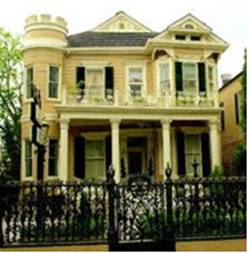
Location:
9150 Royal St.
New Orleans, Louisiana
The innocent-looking colonnaded structure in downtown New Orleans known as the Cornstalk Hotel was built by the former Chief Justice of the Louisiana Supreme Court, in the early 1800s. The former residence and now hotel got its name by the cornstalk cast construction of the iron fence that surrounds the property. The beautifully crafted iron fence, perhaps the most recognizable symbol of the French Quarter, is designed to look exactly like a cornstalk ready for harvest. At the base of the fence are pumpkins intertwined with morning glory vines.
It is said that the fence was designed by one of the earliest owners, who married a young bride from Iowa and brought her to New Orleans to live. To ease her homesickness, he had the cast iron fence constructed so that she could see her own "waving fields of corn" from the window. Today, the Cornstalk Hotel still serves visitors with traditional southern grace and hospitality, as well as the presence of a ghost or two.
According to visitors who have stayed at the hotel, ghostly children have been seen and heard playing throughout the house and the grounds surrounding the property. Numerous overnight guests have reported hearing footsteps in the hallway as well, with no one to be found.
As with many vacationers and guests at the hotel, cameras are an important travel necessity and accessory. The most unique thing about stories coming from the Cornstalk Hotel is that travelers, upon looking at their digital camera images or following development of film from their cameras, are surprised to find pictures of themselves lying fast asleep in their beds. Who is taking these pictures? Guests who have experienced such phenomena are often left to wonder if children are busy photographing and causing other mischief while they sleep.
Hotel Provincial

Location:
1024 Rue Chartres,
New Orleans, LA
Visitors staying at the Hotel Provincial often get more than they bargained for after checking in. The hotel has quite a reputation in New Orleans, and word has spread, thanks to travel-based websites such as Trip Advisor. Now, the stories of ghosts, hauntings, and paranormal activity at the Provincial Hotel are growing in scope, thanks to first-person stories of the goings on there.
The Hotel Provincial is located in New Orleans’ French Quarter on Chartres Street. During the Civil War, the structure served as a temporary hospital for Confederate Soldiers. Most of the stories and incidents regarding paranormal activity revolve around this time period. Numerous visitors claimed to have seen hospital scenes, bloodied bandages, injured Soldiers, and makeshift operating rooms.
Even before the Civil War, the property was used as a hospital as far back as 1722. The original building was torn down generations ago, and two additional structures have been built in the same location over the years. After the building was destroyed by fire in 1874, a new building was constructed, owned by a seed company. In 1969, the building was sold to the Dupepe family, and since then, the structure has served as a hotel, but offers visitors much more than a comfortable bed at night.
According to witness statements, most of the haunts in the hotel appear to be residual. What most people see at the location are Soldiers in military clothing, either of the early 18th century or the Civil War era. Groans, moans and cries of pain are often heard, and when apparitions are seen, they’re bloodied by combat injuries. The sick and wounded seem to perpetually suffer here.
There's also a story of a little girl who stayed at the hotel with her family. She had taken a shower, but when she stepped out, was surprised to find that she had to step over a pile of what she thought were towels. Upon closer inspection, she realized the towels weren’t towels at all, but a pile of blood-soaked sheets and bandages. Another instance records the events as experienced by a security guard on the property. As he stepped out of one of the elevators, intent on completing his rounds, was startled when the space in front of him suddenly transformed into what looked like a hospital ward, filled with wounded Soldiers.
Not everyone who stays at the Hotel Provincial experiences paranormal activity, but some visitors do hear strange sounds and noises that can't be explained; water faucets tend to turn on and off by themselves, and many people claim to feel a heaviness in the air in numerous rooms throughout the property.
Additional hotels in New Orleans, mostly located in or near the French Quarter, also have reported spiritual or paranormal activity, too numerous to list within the confines of this book.
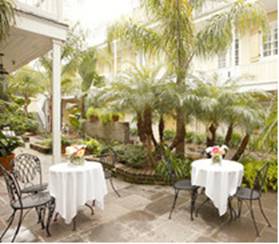
The Dauphine Orleans Hotel, located on Dauphine Street, is one beautiful location that is often visited by apparitions of Civil War Soldiers. Many of these Soldiers have well-dressed ladies on their arms. The property was originally a bordello, and numerous people have seen the apparition of dancing ladies, a bar scene, and Soldiers meandering through the courtyard.
At night, some guests have experienced bouncing and shaking beds early in the morning or later in the afternoon. What causes such bouncing and shaking we’ll leave up to the imagination of our readers. The hotel is quite old, originally constructed in the mid-1700s, with a rich history of activity and claims of strange knocking on doors, moans, and unexplained voices.

The Lafitte Guesthouse, located on Bourbon Street, is a 14-room Civil War era mansion now turned guesthouse, with haunts of its own. It's claimed that a mother and two children died in Room 21. One of the children died during one of the New Orleans yellow fever epidemics, while another child hung herself in the room. Today, people claim to hear the mother crying, and many report a heavy sense of sadness in the room. The little girl who died of the fever reportedly appears in a mirror that used to belong to Room 21. Lights turn on and off throughout the property
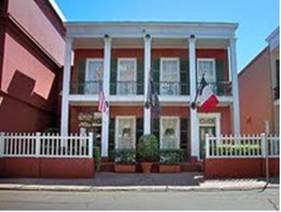
Another haunted location is Le Richelieu Hotel, located on Chartres Street. Historical records imply that the hotel sits on property that was once used as an execution ground, when the land was fought over by French and Spanish forces. According to history, Spanish Soldiers were shot for treason on the property, and it is said that the spirits of these Soldiers walk the grounds of the hotel, and are often seen near the small bar and swimming pool on the property.
Madame Lalaurie Mansion

Location:
1140 Royal St
New Orleans, Louisiana
The Madame Lalaurie mansion, an innocent looking mansion on the corner of Governor Nicholls and Royal Street, has a dark and infamous history in New Orleans.
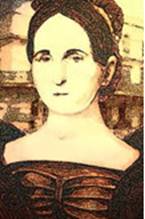
Delphine and Dr. Louis Lalaurie owned the house in the early 1800s. Madame Lalaurie, as she became known, was a prominent New Orleans socialite. She and her husband had dozens of slaves that attended to the details of their social gatherings, and it was an honor to make it onto their invitation list, as the couple was very well respected in the city. This was the side of Madame Lalaurie that the community knew, but there was another very dark and cruel side of her that would later be discovered.
It wasn't until the home caught fire in 1834, that numerous slaves were discovered chained in the attic, abused, starved, and worse. A few of the slaves were alive, but most were dead. All of them had been tortured in the most vicious and brutally cruel manners, all with the intent to die a slow, excruciating death.
We won't go into the stories of what was done to these poor individuals (you can read all about it by delving more deeply into the history of Madame Lalaurie). Suffice it to say that it was horrible, with makeshift operating tables, cages, buckets filled with body parts and organs, and other forms of torture that only a twisted and very disturbed mind could envision.
Reports of ghosts and paranormal activity on the property date back to the early 1800s. The property has passed through numerous private owners, who would only hang on to the property for a little while before moving out, frightened and horrified.
In the years between the Lalaurie ownership and modern days, there have also been multiple businesses and shops that have occupied the building, but have all closed down; many of them claim unexplained events. Other claims are rampant, including windows and doors opening and shutting by themselves, the sounds of rattling chains, human cries, and a rather gruesome bit of residual haunting of a young child being violently murdered.
The young girl that haunts the mansion is thought to be the ghost of the Madame’s personal servant, who apparently grew very angry with her one day when she snagged the Madame’s hair while combing it. Legend has it that she chased the young girl with a whip out onto a balcony, where the girl jumped to her death.
This was the beginning of the end of the Lalaurie’s in New Orleans, as the horrific murder was witnessed by a neighbor, who reported what she saw. The slaves were impounded, only to secretly be purchased back and returned to the wretched lady later. Things were never the same, however, and the social community in New Orleans snubbed the Lalaurie’s, as rumors of the couple’s mistreatment of slaves spread throughout the city.
After the fire in the home where the chained and tortured slaves were discovered, word spread quickly of the brutality committed by the Lalaurie’s. People in the community were outraged, threatening the couple’s lives. Madame Lalaurie was thought to have acted alone in her crimes, but it is believed that her husband was aware of what was going on and did nothing about it. The Lalaurie’s fled New Orleans and were never heard from again.
According to written accounts from the 1800s to the present day, the history of the property is well known. The home was used by Union Troops as a headquarters during the Civil War, and following the war in the 1870s, the building housed a gambling joint. Even then, claims of strange lights, poltergeist activity, and shadowy-figures were common. Through the years there have been reported apparitions of slaves walking the property and even one account of a man who claims he was attacked by a black man in shackles.
In the 1940s, workmen claimed to have dug up human skeletons from under the house, and the owner at the time struggled to overcome the mansion’s horrible reputation. He claimed that the house had been built on Indian and Spanish burial grounds. His claim didn’t ring true. The reputation of the Lalaurie’s literally haunted every home in the area, even after many years had passed. Studies of the bones unearthed beneath the house were discovered to have been placed there well after 1803, and it is believed that many slaves that belonged to the Lalaurie couple had been tortured and buried under the house for years.
To this day, residents and visitors to the infamous "haunted house" on Royal Street continue to claim the presence of poltergeists, ghosts, unexplained noises, and apparitions. Screams, footsteps, and the murmur of quiet voices are still heard today, but none of the activity is deemed harmful to visitors or guests - yet.
The Beauregard-Keyes House

Location:
1113 Chartres Street
New Orleans, Louisiana
The Beauregard-Keyes House, built in 1826, is a famous structure in New Orleans, designated as a historic home. Today, the home serves as a museum, filled with antiques and memorabilia from the era so that visitors taking tours of the property can see how life was lived in early 1800s. The home may offer more than a tour though, as it's reported to also be haunted.
The home is named after two residents who have lived there previously; Confederate General Peter P.G.T. Beauregard and author Frances Parkinson Keyes. The property is on the National Registry of Historic Places, and is often used for party events, weddings, and receptions. The gardens surrounding the home are beautiful and well cared for, as is the fully restored interior of the property.
The home has seen numerous historical events, and during the day is one of the most beautiful and peaceful locations you could ever wish to visit. However, nighttime is rather different, and visitors to the property at night have reportedly heard the sound of gunfire and cannon fire around the house. From inside, visitors have also claimed to hear noises and men screaming outside.
According to local legend, the house was not reported to be haunted before General Beauregard's demise in 1893, but in 1909, the home experienced some violence, with gunshots reported during a party. Three men were killed, the victims supposedly members of the Mafia. The property was soon abandoned, and in the 1920s, a Historic Association and the city purchased the house and transformed it into the General Beauregard and Civil War Museum.
It wasn't until after WWII ended in 1945 that the rumors of ghostly hauntings of the Beauregard-Keyes House by military personnel swept through the community.
Today, owners of the property claim no knowledge of supernatural activity, but visitors beg to differ. At nighttime, Chartres Street is one strange place to be, and with numerous reported haunted locations along its length, it's hardly a wonder that the Beauregard-Keyes House would remain inhabited by a specter or two.
Sultan's Palace (aka the Gardette-LaPrete House)
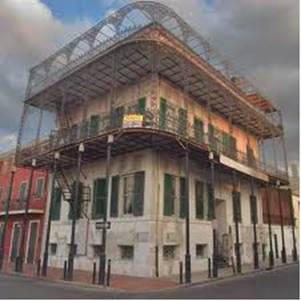
Location:
716 Dauphine Street
New Orleans, Louisiana
The Sultan's Palace, located in New Orleans, isn't really a palace, but rather a very fancy house. While it doesn't look like much, and lacks elegance on the outside, it was quite the spectacle back in the day, and the inside is exquisite. Located in the French Quarter, the four-story house is said to be haunted by a Sultan.
Jean Baptiste LaPrete built the house in 1836, but during the lean years of the Civil War and the occupation of New Orleans, he rented out his city house, while he remained on his plantation in another parish.
The man he rented his home out to was a Turkish prince named Sulyman, who claimed that he was a Sultan. So, it seemed natural that he brought several wives, extended family members, and a large crowd of servants and slaves with him. He soon redecorated the entire house in his own style, covered the windows and placed Turkish eunuchs to guard his doors.
Apparently, the rumors started when people began noticing the large number of girls - and some boys – entering the residence, but not leaving. Rumors floated around town that women were kidnapped and forced to join the Sultan's harem. No one knew whether the stories were true or not, until one morning when a neighbor realized the house was unnaturally quiet and that the front gate had been left open. Upon closer inspection, blood was seen dripping from one of the upstairs galleries, and upon even closer inspection, seemed to be oozing from beneath the front door as well.
When police arrived, they were met with a scene of horror. Inside, they found dismembered bodies throughout the house. Guards, women, and children were found beheaded. One body in the house was intact. Where was the Sultan? He did not escape the carnage, but had been buried alive in the ground behind the house. The police are reported to have found his makeshift grave, with one hand reaching upward through the dirt. After unearthing him, they discovered he was clothed in funeral garb, as per Muslim tradition.
There was a pirates’ ship docked in New Orleans at the time, and one theory the police had was that the motive for the massacre was robbery, though there was no solid evidence to back up such a scenario. Sometime later police learned that the prince was not really a Sultan, but his brother was. Reportedly, the "Sultan" had escaped his country in fear of his own execution and had gone into hiding in the New Orleans residence. Rumor had it that he had stolen treasures or riches (including gold, jewels, and roughly six wives that he had taken from his older brother), and they had finally found and caught up to him.
Regardless of the true reason for the mayhem, all the valuables were discovered to have been taken from the house, leaving behind rooms that had been ransacked. Blood stains were found everywhere. Decades apart, former tenants claimed to have seen the same apparition roaming the house, believed to be the Sultan haunting the property.
You can imagine that the house is reported to be extremely haunted, not only by the Sultan, but other individuals – including those who had been murdered there. Visitors to the property claim that they hear screaming and strange thuds that they imagine are the sound of body parts hitting the floor. Many visitors also report smelling incense and hearing strange music. A young blonde believed to be a Sultan is often seen at the window, only to disappear.
According to the history of the house, it has experienced many owners following the massacre inside. Known also by the name of the Gardette-LePrete House, the Sultan's Palace is still reputed to be one of the most haunted locations in New Orleans.
The Griffon House
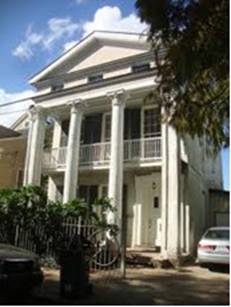
Location:
1447 Constants St.
New Orleans, Louisiana
The Griffon House has been reported to be haunted for generations. Adam Griffon built the home in 1852, but he was forced to abandon his property during the occupation of New Orleans during the Civil War.
General Butler's Union Troops invaded the city and took over many of the fine residences, including that of Adam Griffon. However, it is rumored that these first occupiers of New Orleans were startled by the sound of moans, groans, and rattling chains that came from the upstairs of the residence. Rather than being ghosts, the Union Soldiers found slaves shackled to the walls in the attic; many of them had been starved for quite some time.
According to the history of the location, two deserting Confederate Soldiers, disguised as Union Soldiers, had been captured for looting and held at the Griffon House. The two Soldiers knew that if it the Union Soldiers actually discovered they were Confederates, they would be shot. They spent much of their time in captivity drinking whiskey and singing “John Brown’s Body”. By singing the song over and over again, the two men had hoped to throw off any suspicion that they were Confederates. Feeling hopeless, they committed a double homicide, and were found one morning when their blood dripped through the floorboards into the occupied room below.
Nothing much happened on the property until the 1920s, when an older man who had purchased the house disappeared without a trace. Neighbors and acquaintances of the old man recalled hearing his stories of strange things that were going on in the house, but he never elaborated. Ever since then, visitors and property owners have claimed to see strange things there. Heavy footsteps caused by boots have been heard on the third floor, and screams and the sound of chains rattling in the attic are common. Two pale Confederate Soldiers disguised in Yankee uniforms are often seen standing at the third-floor window, and many claim to hear them singing "John Brown's Body."
According to one story, an employee who worked at the house in 1936, when it served as a lamp factory, was surprised by a door suddenly opening nearby, followed by the sound of boots marching into the room. More footsteps followed, so loudly that the frightened man ran out of the room and to the head of the stairs, intending to run out of the house. Just then, the boot steps faded, followed by the sound of drunken laughter and once again, the song “John Brown's Body" was heard. The worker scrambled out of the house and never returned.
The next owner of the property claims that a large chunk of cement was literally thrown at him from the top of the stairs. There was no sign of anyone upstairs, and all the doors and windows in the upstairs rooms were locked.
As the years passed and owners could not be tempted to hang on to the house for long, it turned into a rooming house. One older woman who had a room on the second floor was sewing and minding her own business one day when she noticed blood dripping on her arm. After realizing that the blood was not hers, she looked up and saw blood dripping through cracks in the ceiling above her chair. Then, from the third floor, she heard two drunken men singing "John Brown's Body." She, like other residents and tenants, ran from the house and never returned.
During the 1970s the house and the surrounding neighborhood had deteriorated to the point to where it was frequented by vagrants and drug addicts, both of which did not occupy the place for long and were sent running by “spooks dressed in uniforms.”
Today, the home belongs to a local owner and his family. They claim they have not witnessed any supernatural or paranormal activities on the property. Perhaps the two Confederate Soldiers like their new tenants, or they finally grew bored with their antics and moved on.
New Orleans is a beautiful city, which offers visitors a plethora of things to see and do. It is no wonder that New Orleans is one of the most popular U.S. locations for travelers and tourists. If you have the opportunity to visit New Orleans, we highly recommend catching one of the ghost tours available. With hundreds of people experiencing the same strange sights, sounds and experiences, it's quite likely that the majority of the stories of haunted locations in New Orleans are indeed true – so, check them out for yourself!